Meet 8 artists who call New Mexico home
This story was featured in the August 2016 issue of Southwest Art magazine. Get the Southwest Art August 2016 print issue or digital download now–then subscribe to Southwest Art and never miss another story.
Kathleen Frank
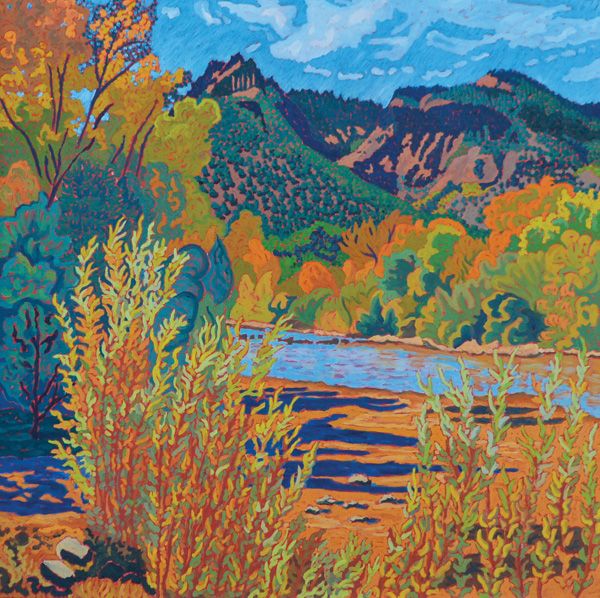
Kathleen Frank, Trails End at the Rio Grande, oil, 42 x 42.
Kathleen Frank still remembers painting her first cow in second grade. “Everyone oohed and aahed over it, saying I was the only one who put the udders in the painting,” laughs Frank. Despite her talent, Frank didn’t consider herself an artist until much later.
Frank’s parents were teachers, but her mother also wrote and illustrated poetry, and the family spent summers traveling the world. Their interest in education and the arts rubbed off on Frank, who earned a degree in design and a K-12 teaching certification. The native Californian went on to teach art, raise a family, earn a master’s degree in printmaking, and establish a printmaking studio workshop. But when Frank moved with her husband to Santa Fe 14 years ago, she dedicated herself fully to oil painting.
Influenced by her printmaking background, Frank is always on the lookout for stimulating patterns and colors. “I love arroyos in the fall when the chamisa are yellow, and the saltbush with pink flowers against the orange rocks,” she says. “When we go hiking, I see things differently than my hiking buddies. They’re looking at birds and plants, and I’m looking for a painting.”
Frank’s work can be seen at La Posada de Santa Fe, Santa Fe, NM; Madeline Hotel, Telluride, CO; and www.kathleenfrankart.com. —Kim Agricola
Heather Ward
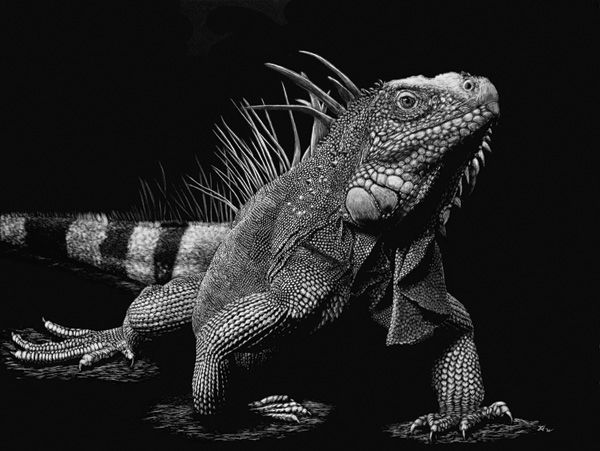
Heather Ward, All About Attitude, scratchboard, 9 x 12.
Artistic inspiration may attract many painters and sculptors to New Mexico, but it was science that initially brought Heather Ward here. With bachelor’s and master’s degrees in math and physics, she accepted a position at Los Alamos National Laboratory, 27 miles northwest of Santa Fe, as did her husband, Rob.
After leaving her job there in 2005 and having the first of her and Rob’s two children in 2007, Ward decided to pursue her childhood passion for drawing animals. “New Mexico has such a huge art scene, even in this town of Los Alamos where we live, that I found it inspiring and beneficial,” she says. She also found endless inspiration in New Mexico’s abundant wildlife, which she can view and photograph even on short jaunts, as well as in animals she can view on zoo visits with her children.
Working first in pencil, the self-taught artist delved into books on drawing and soon progressed to charcoal. “I liked the dark contrasts I got, which really made my subjects come to life,” she says. Then in 2014, she discovered scratchboard, a medium in which lines are scratched through a black surface to reveal the layer of bright white clay beneath, which made her highly realistic images seem vibrantly alive. “Suddenly,” she notes, “people at the juried exhibits where I’ve shown were taking more notice than ever.” Ward’s work can be seen at www.heatherwardwildlifeart.com and in a solo exhibition next spring at the Los Alamos County Library. —Norman Kolpas
Roxanne Swentzell
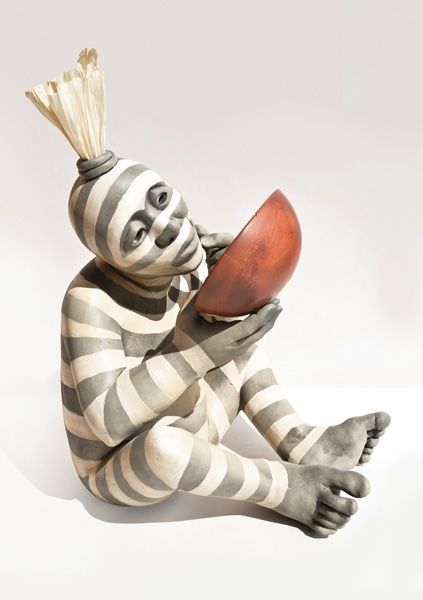
Roxanne Swentzell, Planning My Escape, earthenware, 18 x 12 x 15.
“My roots in New Mexico go further back than the name New Mexico,” says sculptor Roxanne Swentzell. A native of the Santa Clara Pueblo, she is the latest in a long matrilineal line of potters who have coiled clay into vessels and figures.
Traditional though her training was, however, Swentzell adds a distinctively modern spin to her works. Her PORTRAIT OF A CLOWN, for instance, presents a familiar black-and-white striped sacred jester, who might ordinarily be shown in mid-dance; but here, she captures him as if posing for a studio portrait. “It’s a commentary on human vanity,” she says. “‘Look at us posing, how we get prettied up for our pictures!’ You can tell hard truths through clowns, because humor helps the medicine go down.”
Credit her personal approach, in part, to her studies at the Institute for American Indian Arts and the Portland Museum Art School. The approach also stems from the unique role clay has always played in her life. “As a child, I had a fairly bad speech impediment. So my mother gave me clay to sculpt into little figures that communicated what I wanted to express. I still use it over language, because it conveys more. If a picture is worth a thousand words, then maybe a sculpture is worth a million.” See Swentzell’s works at her own Tower Gallery in Pojoaque Pueblo, NM; at Santa Fe Indian Market this month on the Plaza; and at www.roxanneswentzell.net. —Norman Kolpas
Ed Samuels
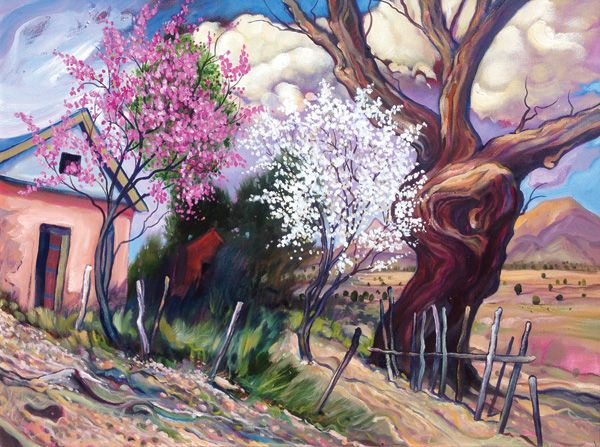
Ed Samuels, Bell Tower, oil, 24 x 30.
As a boy growing up in the Bronx in the 1940s, Ed Samuels never questioned his plan to become a fine artist. “My aunts and uncles were very artistic,” he says. “I grew up seeing their paintings on my grandparents’ walls, so I knew you could do it. That was a secret that was open to me very early on.”
Samuels studied with abstract painter Ilya Bolotowsky and other artists at the State University of New York at New Paltz, then focused on more traditional painting at the School of the Museum of Fine Arts in Boston. After college, Samuels flourished as a professional artist in New York City, where he sculpted, painted, and rubbed shoulders with pivotal movers and shakers in the local art scene, including legendary New York art dealer Allan Stone. Yet, despite his artistic success there, Samuels grew disenchanted with the city and ventured west to Santa Fe in 1982. “When I moved out here—boom—I went crazy with color,” he says.
Today Samuels works out of a stone-and-stucco home he built at the edge of the Santa Fe National Forest. His vibrant oil paintings portray Spanish Colonial churches, timeworn adobes, red sandstone mesas, and other New Mexico charms in an animated, fauvist style. “I’m in the last quarter of my life, and I get it—everything disappears,” says Samuels. “This is my homage to my life and to the places I’ve been, to document my feelings about the beauty here.”
Samuels’ work can be seen at Casweck Galleries, Santa Fe, NM, and www.edsamuelsart.com. —Kim Agricola
Mejo Okon
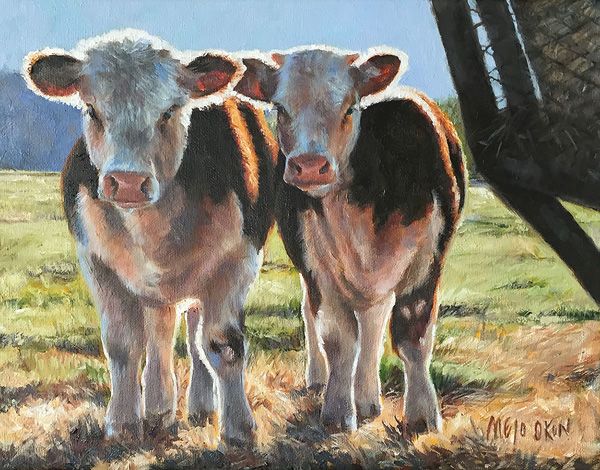
Mejo Okon, Babes, oil, 11 x 14.
Mejo Okon’s oil paintings lasso the heart of the modern West and the soul of its livestock. Her realistic representations of ruminative longhorns, dignified prize cattle, and doe-eyed calves reveal sentient beings brimming with character. “When you get up close, one on one with them, you can see personalities,” says Okon, who bestows these works with endearing titles like Freckles, Dapper, Domino, and Sprout.
But the artist’s contemporary western oils express more than her love for animals. Many works depict working cowboys, rodeos, and ranch life—subjects that stole her heart early in life. As a child, the Indiana native wore cowboy boots, owned cap guns and a pony, and loved western-themed TV shows like “Spin and Marty” and “The Cisco Kid.” Destined to paint the West, she also drew the horses that grazed in the pastures nearby. In high school, the budding artist discovered clay, pastels, oils, ink pens, and T-squares—a sampling that prepared her for design school, says Okon. After earning a bachelor’s in fine art from Herron School of Art and Design in Indianapolis, she donned numerous creative hats, from advertising art director to courtroom sketch artist.
Now you can find Okon at her home studio in Albuquerque, NM, wearing her hat of choice: full-time painter. “Lately, I’m painting more horses. I can’t say I’m a landscape painter, but I think there will be mountains and sunsets showing up in the backgrounds, too,” says the self-described colorist. “When the sun goes down, the colors just explode.” Okon’s work can be seen at Casweck Galleries, Santa Fe, NM; Capital Fine Art, Austin, TX; and www.mejookon.com. —Kim Agricola
Greg Skol
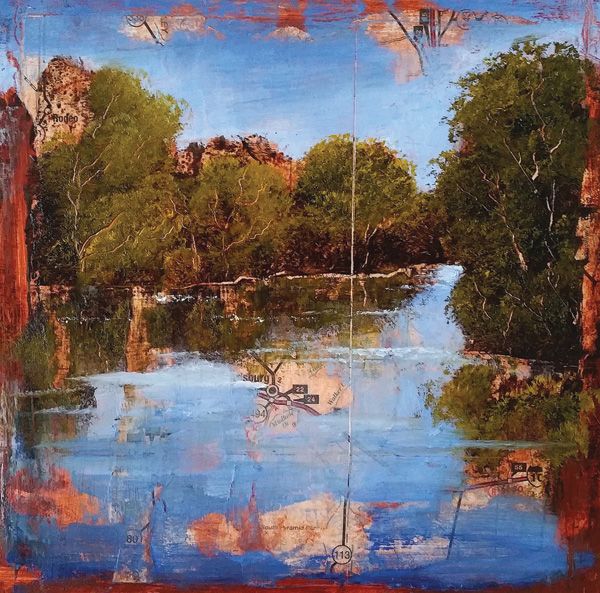
Greg Skol, Untitled (Paper Towns #1), oil/mixed media, 6 x 6.
In grade school, Greg Skol spent countless hours reading the Encyclopedia Britannica, stopping often to draw the images from the pages. “I probably spent three months on butterflies alone,” he laughs. Today, the artist channels his creative energy into painting New Mexico landscapes in a style akin to romantic realism. “I’m not interested in the transcription of a place,” he says. “I want to evoke the sense and mood of a place at a certain time of day.”
Skol grew up just south of SoHo in lower Manhattan, where street artists like Jean-Michel Basquiat emerged on the scene by the end of the 1970s. “The street artists were just neighborhood guys,” he says. The avant-garde environment emboldened Skol to experiment with artistic styles on his own before pursuing studies at the School of Visual Arts and the Art Students League of New York. In the end, however, following his inner muse proved to be the best guide. “Everyone has their own vision and voice, and the only way to find it is to stop wrangling with it and listen to it,” he says.
Following his instincts led Skol to Santa Fe, where he has spent the past 25 years exploring southwestern landscapes in oils that range in size from small to large. Recently, he returned to 6-by-6-inch works. “Working small feels right,” he says. “There’s no way to capture the vastness of the landscape, but oddly enough, having a small, intimate experience with it can fill your vision up.”
Skol’s work can be seen at Pippin Contemporary, Santa Fe, NM, and www.gregskol.com. —Kim Agricola
Madina Croce
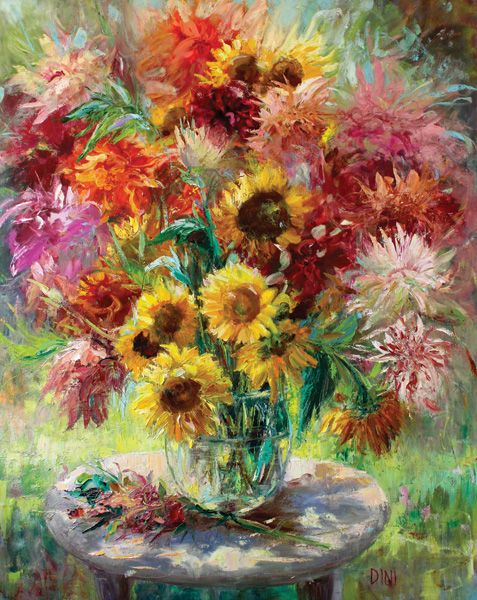
Madina Croce, Last Days of Summer, oil, 40 x 30.
“The clean, crisp, strong light of northern New Mexico is like no other place,” says Madina Croce of the “certain clarity” that local illumination brings to her lush oils of flowers in her garden and the landscapes that surround her. Croce’s works express an intimate connection to her subjects, resulting from a childhood spent first in Taos and then in Santa Fe. Her mother, a concert pianist and classical soprano, filled her early life with music, and her maternal grandmother, a self-taught painter, fostered her artistic talent. “By age 10,” she remembers, “I was winning blue ribbons and even getting commissions to sell my work.”
Sadly, when Croce was 13, her beloved Italian-born father passed away and, she says, “in an act of grief, I just stopped doing art.” She went on to excel in music and dance at the College of Santa Fe and eventually moved to Denver, where she worked as a performer and in the restaurant industry before returning to Santa Fe in 1991.
Croce resumed painting in the summer of 2003 while recuperating from an injury. Her first work, depicting sunflowers in her backyard, was the first to sell in her premiere show. “All of a sudden,” she says, “it felt like I was home again.” Since then, through regular outdoor shows with the Santa Fe Society of Artists and representation at Earthwood Galleries of Colorado, Croce has built a sizable base of collectors, many of whom also visit her home studio by appointment through her website, www.madinacroce.com, where available works are shown. —Norman Kolpas
Thomas Wezwick
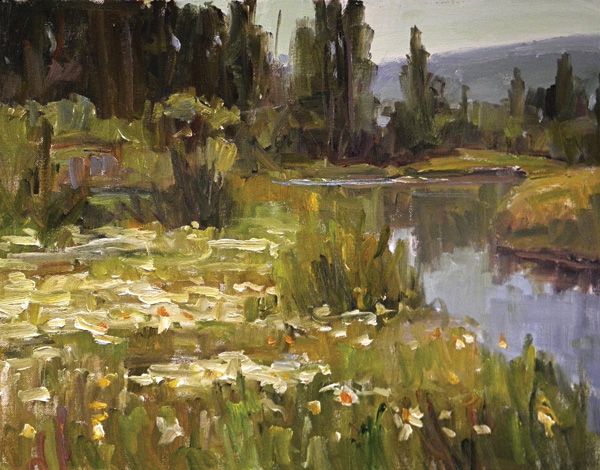
Thomas Wezwick, Endless Field of Daisies, oil, 16 x 20.
As a plein-air painter with an avid fol-lowing for his lush, painterly scenes of northern New Mexico, Thomas Wezwick lives in ideal circumstances. For the past decade, the 64-year-old painter has inhabited a 30-foot yurt he put up himself on 14 wilderness acres at an elevation of 7,000 feet. “All within an hour,” he says, “I can go paint red rocks, rivers, canyons, mountains. There’s a lot of natural beauty here.”
Wezwick paints most of his oils on the scene. “I try to paint quickly, spontaneously, in one sitting,” he says. “If it takes any more than that, it’s gonna look like I struggled on it. I would rather it look almost like an abstract piece that you can recognize as a landscape.” About half the time, though, he will add a few finishing touches in his studio, which he also built on his land from a disassembled old log cabin, adding big windows that revel in the surroundings. “I do have north light,” he says, referring to the indirect illumination most painters prize for its constancy and controlled color values. “And I also have south, east, and west light.”
Whether working indoors or out, Wezwick finds no end to the inspiration of New Mexico. “I could paint here the rest of my life,” he concludes. See Wezwick’s paintings at WarDancer Designs and Gallery, Las Vegas, NM; Weems Galleries, Albuquerque, NM; atwez.fineartstudioonline.com; and on the Facebook pages Paint On!!!!! and Wezwick Fine Art. —Norman Kolpas
Featured in the August 2016 issue of Southwest Art magazine. Get the Southwest Art August 2016 print issue or digital download now–then subscribe to Southwest Art and never miss another story.
MORE RESOURCES FOR ART COLLECTORS & ENTHUSIASTS
• Subscribe to Southwest Art magazine
• Learn how to paint & how to draw with downloads, books, videos & more from North Light Shop
• Sign up for your Southwest Art email newsletter & download a FREE ebook





